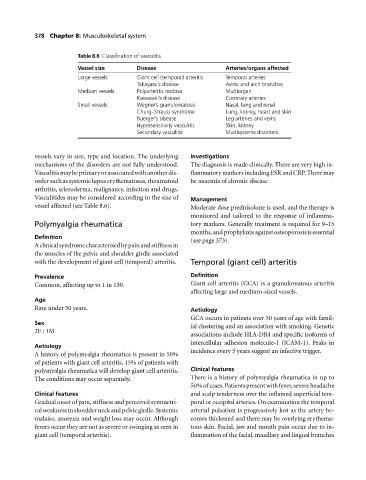Page 382 - Medicine and Surgery
P. 382
P1: KTX
BLUK007-08 BLUK007-Kendall May 12, 2005 19:48 Char Count= 0
378 Chapter 8: Musculoskeletal system
Table 8.6 Classification of vasculitis
Vessel size Disease Arteries/organs affected
Large vessels Giant cell (temporal) arteritis Temporal arteries
Takayasu’s disease Aorta and arch branches
Medium vessels Polyarteritis nodosa Multiorgan
Kawasaki’s disease Coronary arteries
Small vessels Wegner’s granulomatosis Nasal, lung and renal
Churg–Strauss syndrome Lung, kidney, heart and skin
Buerger’s disease Leg arteries and veins
Hypersensitivity vasculitis Skin, kidney
Secondary vasculitis Multisystems disorders
vessels vary in size, type and location. The underlying Investigations
mechanisms of the disorders are not fully understood. The diagnosis is made clinically. There are very high in-
Vasculitismaybeprimaryorassociatedwithanotherdis- flammatory markers including ESR and CRP. There may
ordersuchassystemiclupuserythematosus,rheumatoid be anaemia of chronic disease.
arthritis, scleroderma, malignancy, infection and drugs.
Vasculitides may be considered according to the size of Management
vessel affected (see Table 8.6). Moderate dose prednisolone is used, and the therapy is
monitored and tailored to the response of inflamma-
Polymyalgia rheumatica tory markers. Generally treatment is required for 9–15
months,andprophylaxisagainstosteoporosisisessential
Definition
(see page 373).
Aclinicalsyndromecharacterisedbypainandstiffnessin
the muscles of the pelvic and shoulder girdle associated
with the development of giant cell (temporal) arteritis. Temporal (giant cell) arteritis
Prevalence Definition
Common, affecting up to 1 in 150. Giant cell arteritis (GCA) is a granulomatous arteritis
affecting large and medium-sized vessels.
Age
Rare under 50 years. Aetiology
GCA occurs in patients over 50 years of age with famil-
Sex
ial clustering and an association with smoking. Genetic
2F:1M
associations include HLA-DR4 and specific isoforms of
intercellular adhesion molecule-1 (ICAM-1). Peaks in
Aetiology
incidence every 5 years suggest an infective trigger.
A history of polymyalgia rheumatica is present in 50%
of patients with giant cell arteritis, 15% of patients with
polymyalgia rheumatica will develop giant cell arteritis. Clinical features
The conditions may occur separately. There is a history of polymyalgia rheumatica in up to
50%ofcases.Patientspresentwithfever,severeheadache
Clinical features and scalp tenderness over the inflamed superficial tem-
Gradual onset of pain, stiffness and perceived symmetri- poral or occipital arteries. On examination the temporal
cal weakness in shoulder neck and pelvic girdle. Systemic arterial pulsation is progressively lost as the artery be-
malaise, anorexia and weight loss may occur. Although comes thickened and there may be overlying erythema-
fevers occur they are not as severe or swinging as seen in tous skin. Facial, jaw and mouth pain occur due to in-
giant cell (temporal arteritis). flammation of the facial, maxillary and lingual branches

